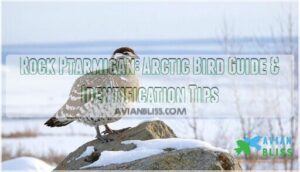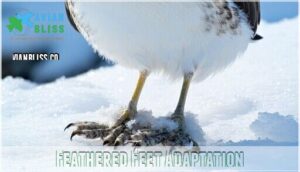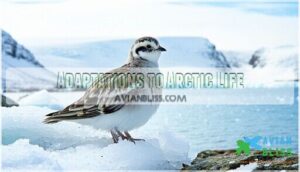This site is supported by our readers. We may earn a commission, at no cost to you, if you purchase through links.
 You’ll recognize a rock ptarmigan by its chunky grouse build and feathered feet that work like natural snowshoes in the Arctic tundra. This master of disguise changes from pure white winter plumage to mottled brown and gray for summer, blending seamlessly with rocks and vegetation.
You’ll recognize a rock ptarmigan by its chunky grouse build and feathered feet that work like natural snowshoes in the Arctic tundra. This master of disguise changes from pure white winter plumage to mottled brown and gray for summer, blending seamlessly with rocks and vegetation.
Found across Alaska, northern Canada, and northern Europe, they’ve conquered some of Earth’s harshest landscapes where temperatures plummet and winds howl. These tough birds scratch through snow for seeds, buds, and leaves, while females nest directly on rocky ground and raise precocial chicks that hit the ground running.
Though currently stable globally, climate change threatens their specialized high-latitude habitat, making conservation efforts increasingly critical for their future survival.
Table Of Contents
- Key Takeaways
- What is a Rock Ptarmigan?
- How to Identify Rock Ptarmigan
- Rock Ptarmigan Habitat and Range
- Rock Ptarmigan Behavior and Diet
- Nesting and Reproduction in Rock Ptarmigan
- Conservation Status and Threats
- Global Population Trends
- Regional Status and Red List Ratings
- Threats From Climate and Predators
- Human Impacts and Conservation Efforts
- What is a rock ptarmigan?
- What does a rock ptarmigan sound like?
- Where does a rock ptarmigan nest?
- Are rock ptarmigans native to Canada?
- How do Rock Ptarmigans adapt to seasonal changes?
- What role do Rock Ptarmigans play in Arctic ecosystems?
- How do humans interact with Rock Ptarmigan populations?
- What are the main threats to Rock Ptarmigan survival?
- How do Rock Ptarmigans compare to other ptarmigan species?
- How long do rock ptarmigan typically live?
- Conclusion
Key Takeaways
- You’ll find rock ptarmigan are Arctic survival masters with feathered feet that act like natural snowshoes and dramatic seasonal color changes from pure white in winter to mottled brown in summer. They’re incredibly hardy birds that thrive in Earth’s harshest tundra environments across Alaska, northern Canada, and northern Europe, preferring rocky areas at least 7-10 miles from human settlements. You can spot them by their chunky grouse build, completely feathered feet, and remarkable camouflage abilities that help them blend seamlessly with snow or rocky terrain depending on the season. * Climate change poses their biggest threat, with projections showing 79.5% habitat loss by the 2080s as warming temperatures shrink their specialized Arctic homes.
What is a Rock Ptarmigan?
You’ll encounter the Rock Ptarmigan (Lagopus muta), an extraordinary Arctic grouse that’s mastered the art of seasonal disguise in some of Earth’s harshest environments.
This chunky, medium-sized bird belongs to the grouse family and earned its scientific name from Ancient Greek words meaning "hare foot," referring to its unique feathered feet that work like natural snowshoes.
Scientific Classification
The Rock Ptarmigan gets its scientific classification from ornithological systems. This medium-sized grouse sits in order Galliformes, family Phasianidae.
The Rock Ptarmigan, scientifically known as Lagopus muta, is classified within the grouse family through established taxonomy systems.
Genetic studies have identified several subspecies of this bird, which are scattered throughout Arctic regions.
Scientists use these classification systems to understand how species evolved and figure out which ones need protection.
Unique Names and Etymology
The name Lagopus has fascinating Ancient Greek roots that tell us exactly what makes these Arctic birds special. It comes from "lagōpous," which literally means "hare-footed"—and once you see a ptarmigan’s feathered feet, the connection clicks instantly.
This isn’t just trivia either. Scientists actually use this "hare foot" feature as a key way to identify and classify ptarmigans within the grouse family. Those fuzzy, feathered feet that reminded ancient Greeks of rabbit paws are still one of the most distinctive traits that set these tough Arctic birds apart from their relatives.
Official Status and Cultural Significance
Beyond survival, this bird holds deep National Symbolism across its range. The rock ptarmigan acts as the official bird of Nunavut, Canada, and official game bird of Newfoundland and Labrador, while Japan recognizes it as a protected "thunder bird." Its Cultural Importance extends from Traditional Significance in Indigenous communities to modern Conservation Status awareness.
- Indigenous reverence: Inuit cultures relied on ptarmigan as one of the only land birds regularly eaten during winter months
- Spiritual symbolism: Celtic traditions view ptarmigan as messengers between human and spiritual worlds, bringing good luck
- Conservation flagship: This Vulnerable species represents Biodiversity challenges in Arctic regions
- Cultural motifs: The bird symbolizes resilience, adaptability, and endurance in harsh conditions
- Protection priority: Conservation efforts focus on this Threatened species as climate change impacts increase
The Rock Ptarmigan’s unique Arctic habitat adaptations play a vital role in its ability to thrive in extreme environments.
How to Identify Rock Ptarmigan
You’ll spot a Rock Ptarmigan by its chunky, grouse-like body that reaches up to 16 inches long and weighs about one pound.
The bird’s most striking feature is its dramatic seasonal wardrobe change—striking white in winter that transforms to mottled brown and gray in summer, plus those distinctive feathered feet that look like fuzzy slippers.
Size and Physical Features
You’ll recognize a Rock Ptarmigan by its chunky body shape and compact build. These medium-sized birds reach up to 40 cm in length and weigh around 500 grams.
Their short, sturdy beak structure helps them forage efficiently in harsh Arctic conditions. Most distinctive are their completely feathered feet—a unique Rock Ptarmigan physical adaptation that sets them apart from other grouse species.
Seasonal Plumage Changes
Rock Ptarmigan identification hinges on their striking seasonal camouflage. You’ll witness three annual molts that transform these birds completely. Winter plumage turns nearly pure white for snow camouflage, while breeding plumage showcases males’ bold black and brown markings.
The molting process creates a patchy appearance as feather coloration shifts from cryptic summer browns back to winter whitening by November. This unique adaptation is made possible by the seasonal molting process, allowing the birds to survive in their harsh environment.
Feathered Feet Adaptation
The Rock Ptarmigan has pulled off one of nature’s coolest tricks with its feathered feet. This isn’t just about looking fancy—those fluffy foot covers actually do three amazing things:
- Snow Traction – Dense foot plumage acts like natural snowshoes
- Cold Resistance – Feathered layers insulate against freezing temperatures
- Arctic Grip – Specialized toe structure provides stability on ice
But here’s the thing—this isn’t where the ptarmigan’s survival magic ends. Their whole camouflage game goes way beyond just changing colors, making these birds true masters of Arctic living.
Rock Ptarmigan Habitat and Range
You’ll find rock ptarmigan thriving in the harshest places on Earth—rocky tundra regions where temperatures plummet and winds howl year-round.
These hardy birds call home the Arctic and subarctic zones across Alaska, northern Canada, Greenland, and northern Europe, preferring remote areas at least 7-10 miles from human settlements.
Preferred Environments
You’ll find Rock Ptarmigan thriving in rocky, dry tundra ecosystems where cold climates shape their world. These alpine fauna prefer harsh, windswept areas at least 7-10 miles from human settlements.
Their rocky habitats offer perfect camouflage adaptation opportunities, while seasonal changes in their environment match their striking plumage transformations. Think desolate, beautiful wilderness where only the toughest survive.
Geographic Distribution
You’ll find rock ptarmigan across Arctic regions and tundra landscapes from Canada to Greenland, Iceland, and Norway. Their global range spans mountain habitats in the Alps and Pyrenees, plus subarctic regions including the Aleutian Islands.
These hardy birds occupy northern territories where few species can survive the harsh conditions.
Adaptations to Arctic Life
Living in the Arctic takes serious survival skills. Rock Ptarmigan physical adaptations help them thrive in harsh tundra habitat conditions where other birds can’t survive.
- Feathered Feet act like built-in snowshoes for walking on deep snow
- Snow Camouflage through seasonal molting keeps them hidden year-round
- Cold Resistance features include dense plumage and compact body shape
- Precocial chicks hatch ready to move, avoiding extended nest exposure
- Camouflage ability switches from winter white to summer brown perfectly
Rock Ptarmigan Behavior and Diet
You’ll notice rock ptarmigan are surprisingly social creatures that spend their days foraging in gender-separated flocks, chattering away with calls that make them easy to spot during spring mating season.
These hardy Arctic birds munch on alpine plants year-round, from tender buds and leaves in summer to hardy seeds and berries when snow blankets their rocky tundra home.
Daily Activity Patterns
Rock ptarmigan are daytime birds, not night owls. They’re busiest at dawn and dusk when they come out to forage for food.
Their Daily Routines revolve around ground-level feeding sessions, punctuated by short flights to escape danger. Diet dictates their Activity Cycles—they’ll spend hours methodically picking buds and berries.
Between meals, expect quiet Roosting Behaviors in rocky crevices.
Vocalizations and Communication
Communication becomes your key to recognizing these Arctic birds. You’ll hear males producing distinctive guttural sounds during courtship displays, creating snoring "kurr-kurr" Mating Songs.
Their Vocalization Patterns include striking Call Structures – from soft clucking "kuk-kuk-kuk" sounds to barking, whimpering, hissing, and rattling notes.
These Communication Methods help identify Rock Ptarmigan Behavior across varying Sound Frequency ranges during the breeding season.
Flocking and Territoriality
Rock Ptarmigan social structure shifts dramatically between seasons, creating fascinating flock dynamics you can observe in the field. These birds practice strict gender separation outside breeding season, with males and females forming separate groups for protection.
Their territorial and breeding behavior follows a predictable pattern.
- Winter flocks – Birds gather in same-sex groups, sharing warmth and predator vigilance
- Spring breakup – Males establish territories through aggressive display flight and courtship display
- Territorial defense – Males use vocalizations and physical displays to mark boundaries
- Post-breeding reunion – Families rejoin mixed flocks after chick-rearing ends
This social flexibility helps Rock Ptarmigan subspecies survive harsh Arctic conditions while maximizing reproductive success.
Feeding Habits and Diet
Through careful observation, you’ll discover these Arctic survivors consume up to 90% plant material annually. Rock Ptarmigan feeding habits center on seeds, flowers, buds, leaves, and berries from over 136 plant species.
Their foraging strategies shift seasonally—winter brings heavy seed consumption and berry foraging from exposed shrubs, while summer offers diverse nutrient intake through fresh plant material.
Nesting and Reproduction in Rock Ptarmigan
You’ll discover that rock ptarmigan create their ground nests in surprisingly exposed spots, relying on the female’s remarkable camouflage to protect 7-9 speckled eggs during her solo 21-day incubation period.
Within just 12 hours of hatching, these remarkably developed chicks abandon the nest and begin following their parents across the harsh tundra landscape.
Nest Placement and Construction
Female ptarmigans aren’t picky about real estate – they’ll scratch out a simple nest anywhere on the ground within their Rock Ptarmigan habitat.
These resourceful birds use whatever nesting materials they find nearby: dried grasses, leaves, and moss line their shallow scrape. The nest site selection prioritizes concealment over comfort, with mothers choosing spots behind rocks or low vegetation for natural camouflage techniques.
Egg Laying and Incubation
Finding a female’s nesting spot opens up a window into something pretty amazing—watching her create and tend to her eggs. Rock ptarmigans have their own rhythm when it comes to raising the next generation.
She’ll settle into her chosen spot and lay anywhere from 4 to 13 eggs, each one a pale buff color dotted with brown markings. Here’s where it gets interesting—she doesn’t start sitting on them right away. Instead, she waits until she’s laid all but the last egg before beginning the real work of incubation.
For exactly 21 days, she becomes a living incubator. Her dedication is complete—constant warmth, steady protection, rarely leaving the nest. Whether those chicks make it depends entirely on her commitment during these three weeks. It’s one of nature’s clearest examples of how much rides on maternal instinct.
Chick Development and Parental Care
Within hours after hatching, ptarmigan chicks showcase notable independence. These precocial young leave the nest immediately, following their protective female through rocky terrain.
Parental investment peaks during the early weeks when chicks learn essential feeding behavior from mom. Brood behavior includes tight clustering for warmth and protection.
Nesting success hinges on reducing chick mortality through vigilant care. Fledgling growth accelerates rapidly in harsh Arctic conditions.
Conservation Status and Threats
You’ll find that rock ptarmigan face a mixed conservation picture, with global populations holding steady at over 8 million birds but regional declines raising red flags in places like Iceland and southern Europe.
Climate change shrinks their mountain habitats while tourism and introduced predators add pressure, making these Arctic specialists a species to watch closely.
Global Population Trends
Across the Arctic, Rock Ptarmigan face an uncertain future. Global estimates show 8 million birds worldwide, but population cycles are shortening and weakening.
Climate impact drives habitat loss as warming temperatures reduce snow cover by 79.5% in suitable areas. Global warming disrupts the delicate balance these birds need.
Conservation efforts and wildlife management now focus on ecosystem protection to reverse declining trends.
Regional Status and Red List Ratings
Different regions tell vastly different stories about Rock Ptarmigan conservation. While the IUCN rates them globally as Least Concern with over 8 million individuals, regional trends paint a more complex picture.
Iceland lists them as Near Threatened due to shortened population cycles and habitat loss. Scotland’s montane populations face ecosystem protection challenges, while Japan’s alpine groups are regionally endangered.
These threat assessments drive targeted conservation efforts across vulnerable habitats.
Threats From Climate and Predators
Climate change poses the greatest threat to rock ptarmigan, with projections showing 79.5% habitat loss by the 2080s. Warming temperatures create chromatic mismatch—when white winter plumage stands out against brown landscapes.
Predators like Arctic foxes and golden eagles cause 89% of nest failures. Conservation efforts now focus on predator control and protecting remaining ptarmigan habitat from human disturbance.
Human Impacts and Conservation Efforts
You’ll often spot rock ptarmigan struggling against modern threats. Human activities like mining, oil extraction, and infrastructure development pose additional threats, while habitat modification and human disturbance threaten their survival.
Conservation strategies focus on protecting existing habitats and monitoring population trends. Ski resorts create particular challenges through tourism impact and habitat fragmentation, making national park protection vital for these vulnerable Arctic birds.
Rock ptarmigan face mounting pressure from human development. Mining operations, oil drilling, and new infrastructure cut into their territory, while constant disturbance from human activity makes survival increasingly difficult.
What is a rock ptarmigan?
You’re looking at nature’s supreme camouflage artist — a chunky Arctic grouse that transforms from snow-white in winter to mottled brown in summer.
These feather-footed birds call the harsh northern tundra home.
What does a rock ptarmigan sound like?
You’ll hear these birds make surprisingly diverse sounds throughout nesting season. They produce soft "wah" calls, clucking "kuk-kuk-kuk" sounds, and guttural snores or rattles—especially males defending territory during breeding season.
Where does a rock ptarmigan nest?
You’ll find these hardy birds building their ground nests in rocky, barren tundra areas.
Females scrape shallow depressions among stones and sparse vegetation, creating simple but effective shelters for their 6-9 speckled eggs.
Are rock ptarmigans native to Canada?
Like finding buried treasure, you’ve discovered that rock ptarmigans aren’t just native to Canada—they’re Arctic royalty!
These hardy birds call northern Canada home and even serve as Nunavut’s official bird.
How do Rock Ptarmigans adapt to seasonal changes?
You’ll witness their striking seasonal transformation as they switch from pure white winter plumage to mottled brown summer camouflage.
Their feathered feet help them navigate deep snow and dig protective burrows.
What role do Rock Ptarmigans play in Arctic ecosystems?
Over 8 million individuals worldwide showcase their vital ecosystem role.
You’ll discover these Arctic birds serve as key prey for predators while controlling plant growth through selective feeding on alpine vegetation, maintaining delicate tundra balance.
How do humans interact with Rock Ptarmigan populations?
You’ll encounter these birds through hunting, birdwatching, and research activities.
Tourism development and habitat disturbance threaten their populations, while conservation efforts monitor breeding cycles and protect critical tundra habitats from climate change impacts.
What are the main threats to Rock Ptarmigan survival?
Walking on thin ice, you’ll find these hardy birds face their toughest challenge yet. Climate change, habitat loss, human disturbance, and overhunting threaten these alpine specialists.
Rising temperatures transform their tundra homes at alarming rates, forcing relocation or adaptation.
How do Rock Ptarmigans compare to other ptarmigan species?
You’ll notice three key differences between ptarmigans: Rock ptarmigans have smaller bills than willows, prefer rockier, barren habitats versus vegetated areas, while white-tailed species keep permanently white tail feathers year-round.
How long do rock ptarmigan typically live?
You’ll find these Arctic survivors usually live 2-4 years in the wild, though if they make it through that brutal first winter, they can reach around four years on average.
Conclusion
Like Arctic royalty wearing nature’s finest camouflage, the rock ptarmigan reigns paramount in Earth’s most unforgiving landscapes. You’ve discovered a bird that’s mastered survival where others can’t even endure—transforming its appearance with the seasons while dancing on snow with feathered feet.
Rock ptarmigan are nature’s ultimate Arctic survivors, transforming from snow-white to mottled brown with the seasons while thriving where few species dare to exist
As climate change reshapes their frozen kingdom, safeguarding these exceptional Arctic ambassadors becomes vital. Next time you’re in ptarmigan country, remember you’re witnessing millions of years of evolutionary artistry in action.
- https://albatros-expeditions.com/discover/rock-ptarmigan-wildlife
- https://www.natt.is/en/fauna/birds/breeding-birds/rock-ptarmigan
- https://besjournals.onlinelibrary.wiley.com/doi/full/10.1002/2688-8319.12390
- https://www.adfg.alaska.gov/index.cfm?adfg=rockptarmigan.printerfriendly
- https://www.birdatlas.bc.ca/accounts/speciesaccount.jsp?lang=en&sp=ROPT












